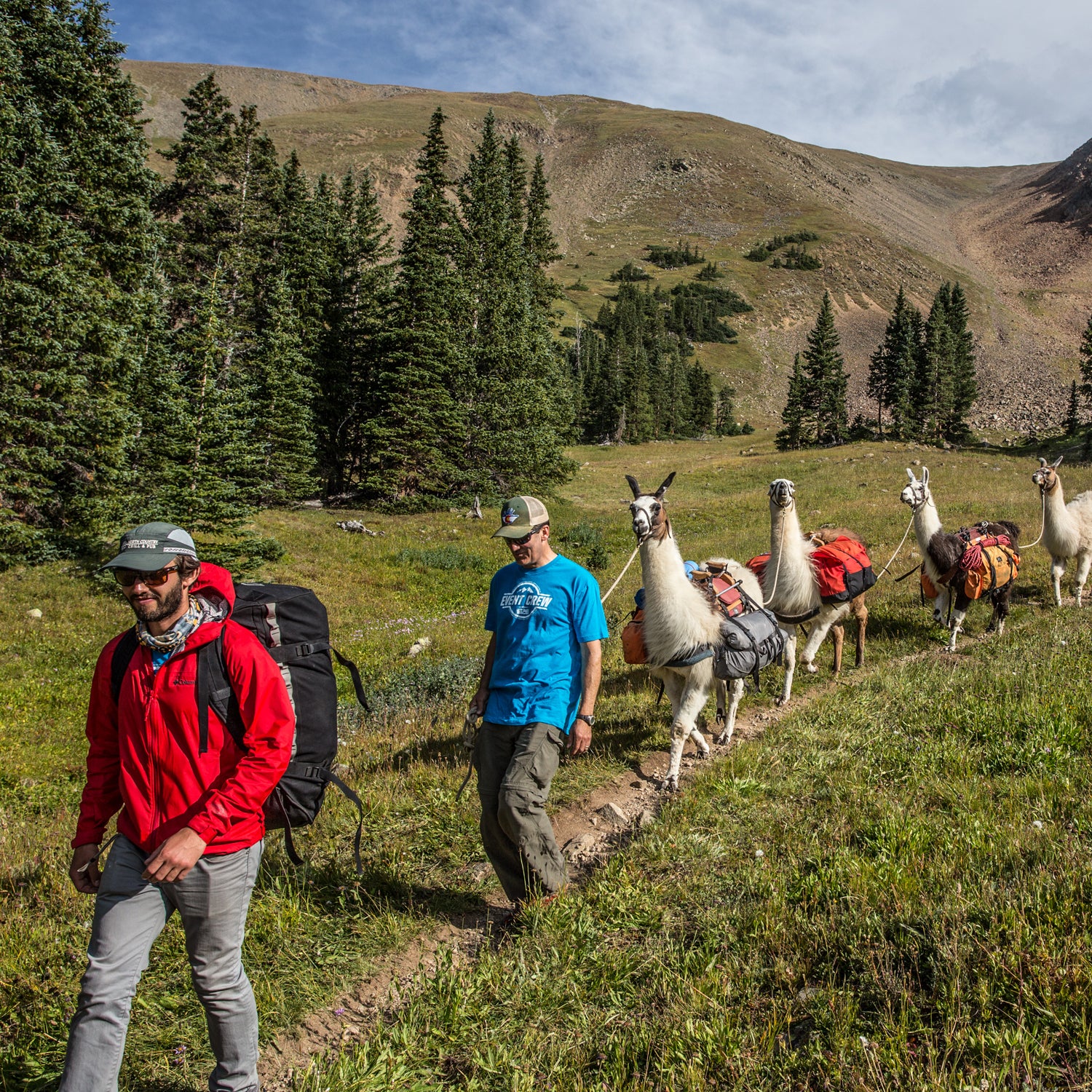If you’ve ever volunteered at a race, you know it can be a sticky, hot mess of a job. Between runners splashing you with Gatorade and old guys asking if you can smear some Vaseline on their blistered heels, it’s the hardest you’ll ever work for a free T-shirt.
But you also know that when an athlete is eternally grateful for your presence, all of it—the sunburn, the lost Saturday, the Gatorade dripping down your sock—becomes worth it.
Some volunteers, however, are not content with just handing out water or packets of gel. For these volunteers, race day has become a proud annual tradition, and their reputation proceeds them. By mile five of a marathon you’ll hear someone saying “just wait until we get to Gorilla Hill,” or “I’m so excited to see the llamas on Hope Pass.”
We love all race volunteers—from the guy flagging on the street corner to the nurses running the medical tent. These five volunteers, however, have taken their do-goodery to another level. Meet the most-loved aid station volunteers in America.
Gary Carlton, Hope Pass Llama Wrangler, Leadville 100
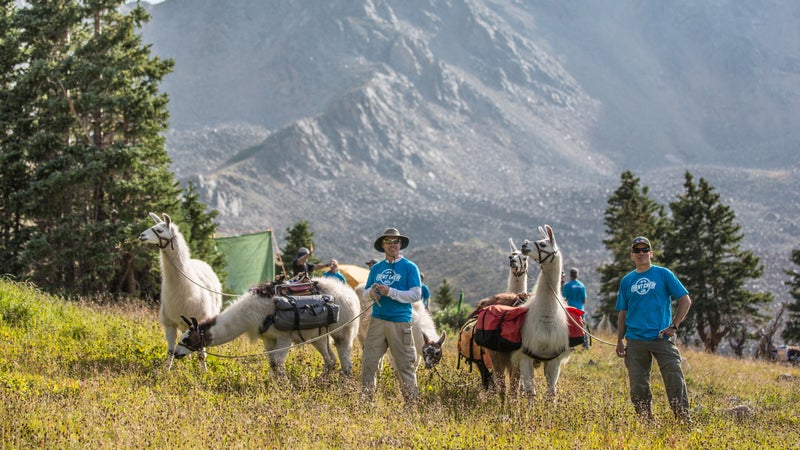
How do you get 3,000 pounds of food and medical supplies up to 12,200 feet? With a train of llamas, of course. For more than a decade, full-time beef and llama wrangler Gary Carlton has been loading up 35 llamas and four mules (some his, some borrowed from friends) and setting up a bountiful buffet at the top of Hope Pass in Colorado—the summit about halfway through the race where many runners drop out.
“We’re up at 12,200 feet for four days,” he says. In that time, volunteers filter and chlorinate 7,000 gallons of water, which they’ll pass out to weary competitors. They also make the aid station’s special soup: “it’s a mix of dried mashed potatoes and ramen. We serve it real liquidy so people can drink it,” says Carlton.
Over the years, things have gone wrong—as things that rely on the cooperation of charismatic megafauna are wont to do. “We’ve had several get loose, and chasing llamas around a mountain valley isn’t that fun. We also had one roll 30 feet off the trail and down to the creek,” he says. (Don’t worry, llama and handler were fine, if a little shaken up.)
Still, he comes back year after year for one reason: the athletes. “They’re very grateful. Last year I had a guy from Tennessee bring me a half-pint of whiskey. I couldn’t believe he thought of me and carried it all that way.”
Banana Don, Ride the Rockies, Colorado
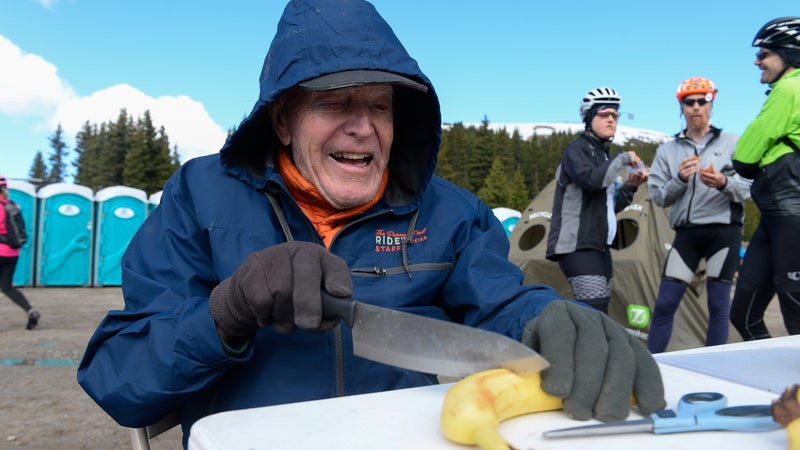
The best thing about being 90? You’ve had nine decades to perfect your banana-cutting skills. And Banana Don, also known as Don Siekmeier, has that skill on lock. Siekmeier has been passing out bananas at Ride the Rockies for four years now, but he’s already a legend—partly for his youthfulness and partly because of his charm.
“I feel like a monkey out there; all I need is a tail,” he says. He gets up at 4 a.m. on race day and is cutting and passing out bananas for hours. “We usually cut, oh, 4,000 or so.” He encourages every rider to take one—sometimes two. “Take one for later! They’re such a healthy food, so full of energy,” says Banana Don, sounding a bit like a Chiquita commercial.
Siekmeier actually owes his involvement in the race to his 83-year-old wife, Gloria. She’s been a volunteer for more than a decade, but when Don showed up to help one year, he quickly became the star (Gloria is a good sport about the whole thing). The pair have no plans on retiring from aid-station duty. Says Don: “As long as I can walk I’ll be out here. It’s an opportunity to meet a lot of nice people and eat bananas all day; what could be better than that?”
The Woody’s Near World Famous Aid Station, Pistol Ultra, Alcoa, Tennesse
When you’ve raced 50 ultras in 50 states, you know a thing or two about what separates the good aid stations from the great. Jeff Woody, an avid amateur runner, knows what you crave at mile 48—and he’s used that knowledge to build the aid station to end all aid stations at the Pistol Ultra in Alcoa, Tennessee.
The takes place on a greenway trail, and the Woody’s are positioned on a mile long out-and-back. This means they can take orders as runners start the out-and-back and have an egg-and-cheese sandwich ready to go when they return. Egg sandwiches are just the beginning, too. The Woody’s make homemade lentil soup, fresh banana bread, wraps with veggies, quesadillas, homemade granola bars plus all the normal aid station fare—like pretzels, fruit and Gatorade. “We’re in an urban environment, so we go and get BBQ from a local restaurant and serve sliders,” says Diana Woody. They’ve even gotten Krispy Kreme donuts and used those as the base for egg sandwiches.
“I work the grill, and Jeff is the front man. He’s got a lot of experience, he’s doctored so many people through. Sometimes he’ll say, ‘okay, you gotta go, if you don’t start moving you never will,’” says Woody. She adds that the whole race feels like a giant party, and that they’ve gotten to know many of the runners over the years.
After watching volunteers be there for her husband over and over again, she loves being there for the Pistol Ultra runners. “I once had a guy come by and ask if we had Mountain Dew. We didn’t, and he said, ‘This is Tennessee, how can you not have Mountain Dew?’ So I ran to the nearest store and got some for his next lap.” Now that’s service.
Dave Pryor, Cyclocross’s Bacon Suit Man
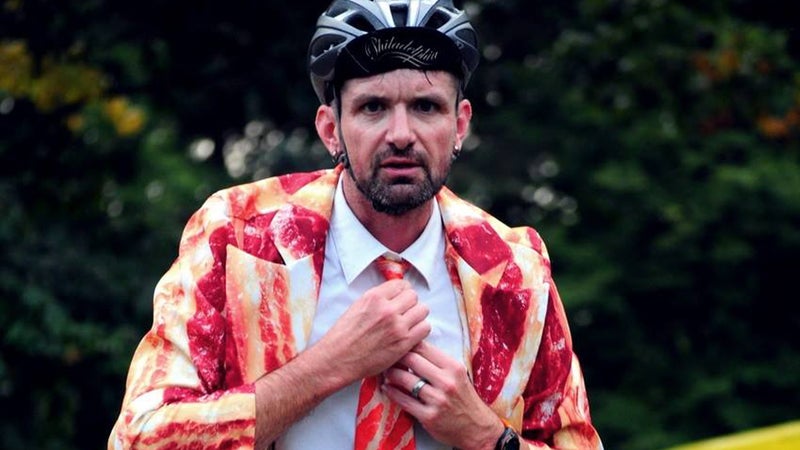
Though hand-ups are technically illegal in cyclocross races, they’re one of the best parts of the sport. And there may be no better hand-up guy than Dave Pryor.
To the uninitiated, hand-ups are when spectators give things (beer, bacon, donuts, dollar bills) to the racers whizzing past. “It brings the racers and the fans together,” says Pryor. Officials don’t always see it that way, since—at least at the elite level—it’s hard to know what kind of magic rocket fuel could be in a bottle. But Pryor, 46, has been “racing” cross since it was a weird, one-off event happening in friends’ backyards, before drug tests and carbon-everythings were a part of Saturday races. And he’s committed to keeping cross weird.
The best way to find Pryor is to look for the large, rowdy group of spectators—he’s probably the organizer. If there’s someone handing out powdered donuts, you can almost guarantee that’s him. And if that guy is wearing a bacon suit, you know you’ve found him.
Perhaps one of Pryor’s proudest moments was when he “won” a race while riding backwards on course giving hand-ups. “It was a men’s A race [the highest amateur level], and there was really low turnout. It was all our friends,” he says. From the gun, it was pretty clear that no one was really racing, so the officials turned a blind eye on Pryor riding a cruiser with beers in the basket the wrong way on course. Eventually the course marshals decided it was time to wrap up the silliness and as Pryor came through the finish area they declared him the winner. “The result is still up on USA Cycling,” he says proudly.
The Chief Gorilla on Gorilla Hill
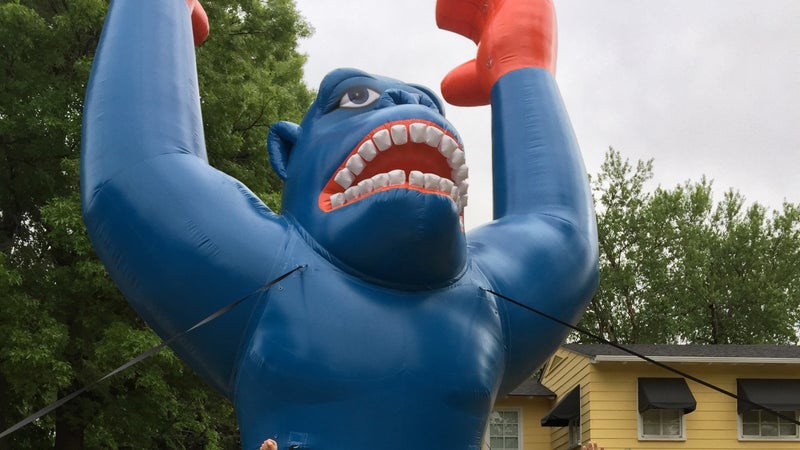
There aren’t too many hills on the course, but the most memorable is—by far—Gorilla Hill. It’s not its length or its steepness that stays with you, it’s the giant, inflatable gorilla and the 60-70 volunteers in banana suits that you remember. And all of it is the work of one man: Steve Cole.
“The course runs by my house, so about 10 years ago we set up a table and started giving out water.” Then, one day while driving around town, Cole saw a giant, inflatable gorilla outside a car dealership. “I decided to rent it, put it out in my front yard and put up a sign that said Gorilla Hill,” says Cole, who is a lawyer in his day job. “It took off from there.”
Eventually, Cole became so invested that buying his very own giant, inflatable gorilla became the most economical option, “they’re expensive to rent,” he says, like buying one of his own was the most reasonable decision he’s ever made. Slowly he added bananas suits to his collection. Altogether, he says he has thousands of dollars wrapped up in Gorilla Hill.
But he loves it. “It’s one of the best days of the year for my kids; all their friends help out. About 30 people sleep on my floor the night before,” he says. And it helps him remember what the marathon is about: Honoring the victims of the Oklahoma City Bombing. “I was downtown the day it happened, it made an impact on me. Yellow is the color of remembrance for the bombing,” he says, adding that having an aid station that’s a sea of yellow is the least he can do to support a city that’s given him so much.


